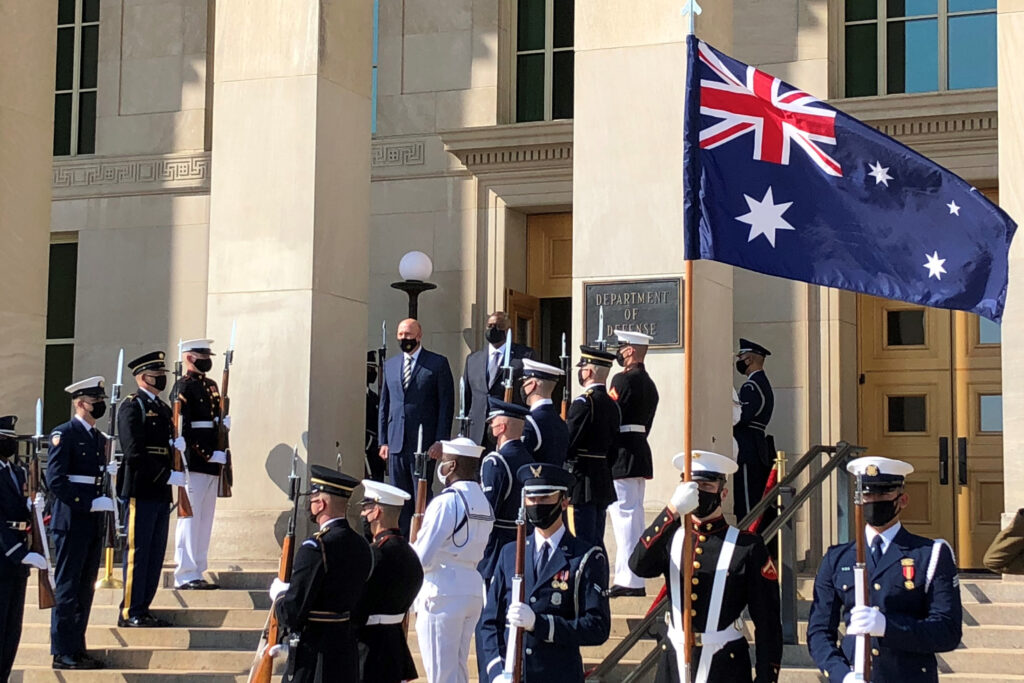
Australian Defense Minister Dutton and Defense Secretary Austin at the Pentagon Sept. 15 2021. (DoD)
WASHINGTON: The US-Australia agreement to build nuclear submarines together is just the tip of the proverbial iceberg, according to remarks today by Defense Secretary Lloyd Austin, his Australian counterpart, Peter Dutton, and Australian Foreign Minister Marise Payne.
On top of the groundbreaking, if clumsily named, AUKUS agreement announced yesterday to help Australia join the six countries with nuclear powered submarines, Dutton announced that his department and the NRO, builder and operator of America’s spy satellites, have a new agreement covering “a broad range of satellite activities.”
While Australia is a member of the storied intelligence group known as the Five Eyes — Australia, Britain, Canada, New Zealand, and the US — working with the highly secretive NRO is a prize to which few countries can aspire.
Interestingly, Australian Minister of Foreign Affairs Marise Payne, who appeared alongside the two defense ministers and US Secretary of State Antony Blinken, stated that in addition to the NRO agreement, Australia and the US will work “to advance the peaceful use of space through a space framework.” No details were provided on just what this means.
On top of all that, Austin noted the two countries inked a “Statement of Intent that will expand our efforts to co-develop advanced defense capabilities,” later adding “And today, we endorsed major force-posture initiatives that will expand our access and presence in Australia.”
The two countries also “agreed to take immediate steps to improve interoperability through deeper integration.”
Given the close military history of the two nations, it’s hard to see how much more integration there could be. But Dutton peeled back a bit of the onion on what “deeper integration” may signal.
“So, I’m proud to announce that Australia and the United States will be significantly enhancing our force posture cooperation, increasing its operability and deepening alliance activities in the Indo-Pacific. This will include greater air cooperation through rotational deployments of all types (emphasis added) of US military aircraft to Australia,” Dutton said during the press conference held today at the State Department.
“We will also establish combined logistics sustainment and capability for maintenance to support our enhanced activities, including logistics and sustainment capabilities for our submarines and surface combatants in Australia,” Dutton added. “These key activities will be complemented by conducting more bilateral exercises and greater combined exercise engagement with partners in the region.”
Moving Beyond AUKUS
Dutton’s mention of “greater engagement with partners in the region” didn’t come with any names attached. But Payne dropped some hints, noting that before she and Dutton came to Washington they “visited Jakarta, New Delhi and Seoul, where we discussed many of the same issues that have been on the agenda here today at today’s meeting.”
The so-called Quad — technically the Quadrilateral Security Dialogue, comprising Australia, India, Japan and the United States — will be central to these efforts as well, both Australians said. The Quad will hold its first face-face meeting on Sept. 24 and, especially after this week’s announcements, will be a “powerful demonstration of the commitment of our four nations,” Payne said.
She and her staff were careful to ensure that Australia, heavily dependent on trade with China for exports of coal and a range of agricultural and mineral products, did not sound like all this was aimed at boxing China in. Like US officials yesterday, she insisted the deal was not aimed at any one country.
“This does not mean there are not constructive areas of engagement with China,” she said, then noting that “US leadership within the Indo-Pacific remains indispensable.”
Austin, for his part, made it pretty clear that China is the problem that needs solving.
“This morning, we had a robust discussion across the full range of those security interests … to include terrorism, climate change, and the increasingly contested security environment in the Indo-Pacific,” he said.
“We spoke in detail about China’s destabilizing activities and Beijing’s efforts to coerce and intimidate other countries, contrary to established rules and norms. While we seek a constructive, results-oriented relationship with the PRC … we will remain clear-eyed in our view of Beijing’s efforts to undermine the established international order.”
Chinese Foreign Ministry spokesman Zhao Lijian said earlier today the agreement would result in “severely damaging regional peace and stability, intensifying an arms race, and damaging international nuclear non-proliferation efforts.
“China always believes that any regional mechanism should conform to the trend of peace and development of the times and help enhance mutual trust and cooperation … It should not target any third party or undermine its interests,” he said at a regular press conference in Beijing.
Meanwhile, as an example of the kind of cooperation taking place in the Indo-Pacific, India and Australia held the fourth version of AUSINDEX in far northern Australia in early September.
The bilateral maritime exercise included communication, maritime maneuvers, and Royal Australian Air Force P-8A maritime patrol aircraft. F/A-18 Hornets were also involved, along with the ships’ embarked helicopters.






















